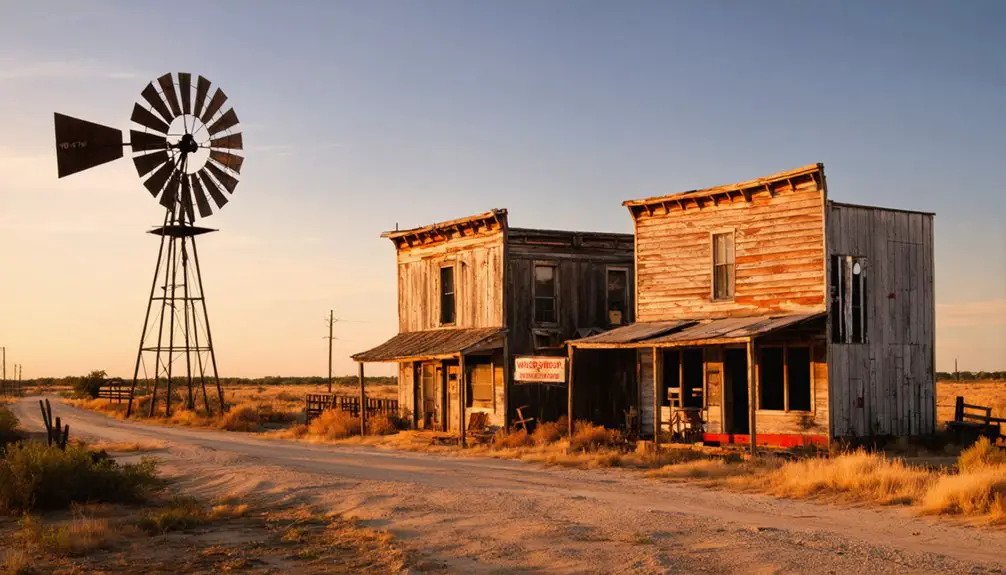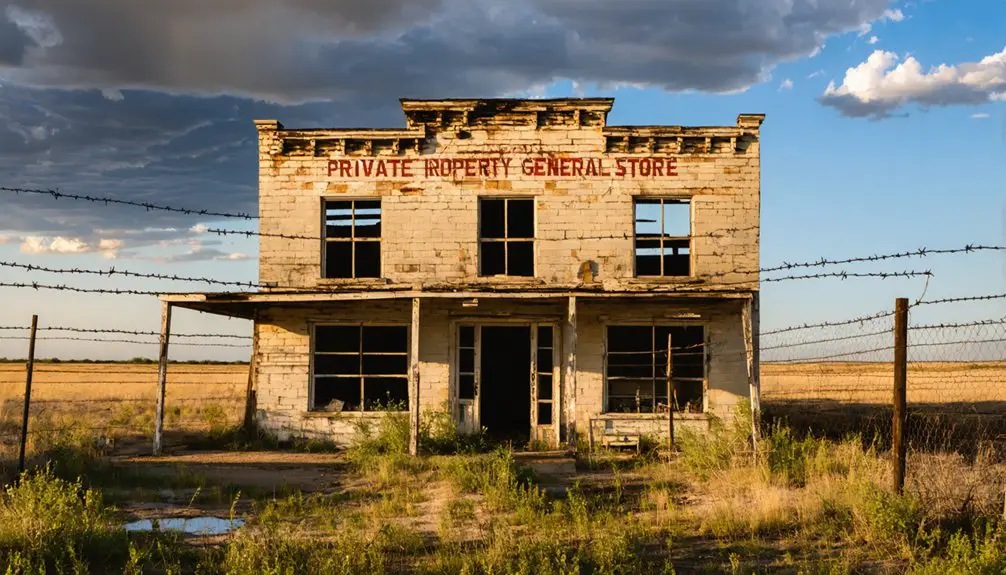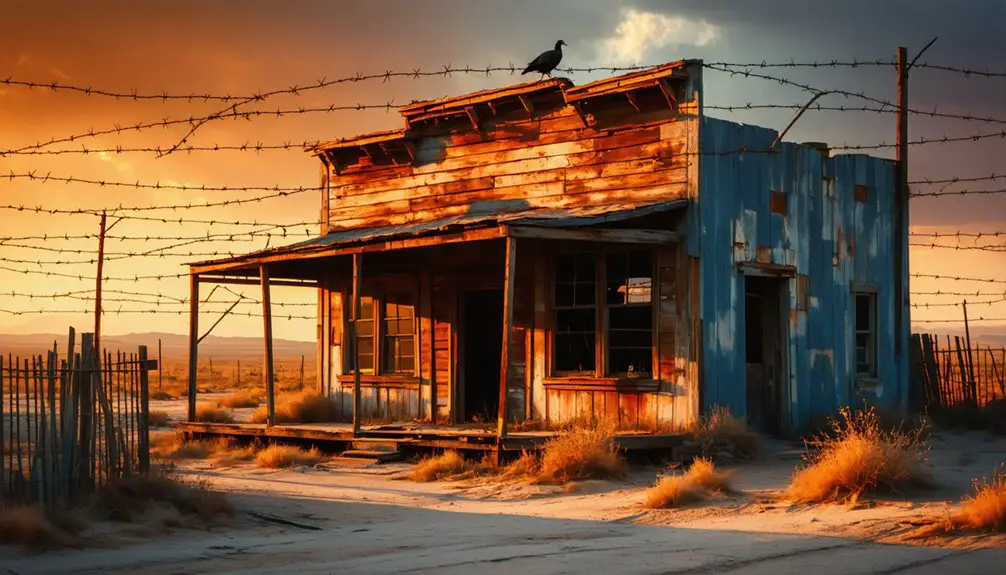You’ll find Ammans Crossing along the Canadian River, where Barney Plemons discovered a safe ford using his quicksand-sensing horse in the late 1800s. The settlement flourished as an essential transportation hub, with early settlers building log cabins and establishing farms. When the railroad bypassed the town in the early 20th century, businesses closed and residents departed. Now a ghost town, its remnants tell a compelling story of frontier Texas’ boom-and-bust development.
Key Takeaways
- Originally established around a vital Canadian River crossing discovered by Barney Plemons, who used a trained horse to detect safe passages.
- Served as a crucial transportation hub with shops and supply stores until the railroad bypassed the settlement.
- Economic decline led to mass exodus, with property values falling 47% and foreclosure rates increasing by 40%.
- The relocation of county administrative functions to Stinnett in 1927 accelerated the town’s transformation into a ghost town.
- Historic preservation faces challenges due to private land ownership, flood risks, and lack of formal historic designation status.
The Discovery of Plemons Crossing
While many river crossings along the Canadian River proved treacherous due to quicksand, Barney Plemons found a reliable ford that would become the foundation of an important Texas settlement.
The Canadian River’s deadly quicksand posed constant danger until Barney Plemons discovered a safe crossing, forever changing Texas history.
In a remarkable feat of river navigation, Plemons used his specially trained horse to detect safe passages through the dangerous waters. This natural advantage made the crossing point invaluable for travelers seeking safe passage across the Canadian River.
The site’s strategic location at a bend where the terrain was significantly shallow and stable attracted early settlers, including James A. Whittenburg, who built a dugout overlooking the crossing in 1898. The small community grew steadily, attracting fifteen pioneer families by 1905.
The discovery marked a pivotal moment in Plemons history, as the crossing’s reliability transformed it from a simple ford into an essential transportation hub that would shape regional development and commerce. The town that grew around the crossing would eventually become the Hutchinson County seat, drawing more settlers to the area.
From River Crossing to County Seat
Much like Plemons Crossing, Ammans Crossing emerged as a strategic river crossing near Bois d’Arc Creek during Texas’s frontier days.
Similar to how German immigrants walked hundreds of miles to find suitable settlements, early settlers faced challenging terrain to reach this vital crossing point.
You’ll find that early settlement patterns centered around Bailey Inglish’s fort, where a small community developed as county affairs were taking shape. By 1838, the establishment of local mail routes connected the growing settlements across Fannin County.
The area’s significance grew as population increased, leading to several key developments:
- The crossing became essential for transportation and commerce in central and southern Fannin County
- Warren was initially selected as the county seat in 1839, though it proved inconvenient
- Local petitions and legislative pressure ultimately established Bonham as the permanent county seat
What started as a simple river crossing transformed into a contested site for county governance, reflecting the dynamic nature of frontier development and the community’s determination to shape their administrative future.
Life in Early Settlement Days

As settlers established themselves at Ammans Crossing in the early 19th century, they faced the demanding realities of frontier life amid dense forests and winding waterways.
You’d find settler communities working together to build log cabins, clear land, and establish rudimentary roads connecting their homesteads. Daily hardships included the constant need for self-sufficiency – men hunted game and tended livestock while women managed households and gardens. The introduction of cattle and sheep by early explorers helped establish sustainable food sources for growing settlements. Many families were drawn to the region by the promise of cheap land prices, with Texas acreage costing just pennies compared to U.S. territories.
Your survival depended on seasonal rhythms of planting and harvesting, plus cooperation with neighbors for barn raisings and crop gathering.
Beyond farming, you’d encounter a diverse mix of Anglo-American, German, and Mexican cultural influences shaping community life. Local militias provided protection from external threats, while informal churches and meeting places served as centers for education, worship, and social gatherings.
Economic Growth and Development
Since its establishment along the upper Guadalupe River, Ammans Crossing emerged as a strategic transportation hub that shaped local commerce.
You’d find the town’s early economy centered around its essential river crossing, which facilitated trade and movement of settlers throughout Kendall County.
The town’s economic foundation rested on:
- Local shops and supply stores serving the frontier community
- Transport routes connecting traders and settlers
- Natural resource utilization and riverine commerce
Much like Indianola’s success as a major shipping port in the 1870s, Ammans Crossing’s location made it vital for regional trade.
Without economic diversification beyond its role as a crossing point, the town remained vulnerable to changing transportation patterns. Similar to how black diamonds of Thurber fueled Texas’s early industrial growth, Ammans Crossing’s strategic location powered regional development.
Like many similar settlements, Ammans Crossing’s prosperity depended heavily on its function as a transport node.
When newer transportation technologies emerged and trade routes shifted, the town’s economic significance began to decline, following a pattern common to many Texas ghost towns.
The Legend of the Quicksand-Sensing Horse
While the story of a quicksand-sensing horse gained prominence in Plemons, Texas, you’ll find similar tales echoing through Ammans Crossing’s history along the Guadalupe River.
You can trace these accounts to the practical need for safe river crossings, where horses with keen instincts could detect and avoid treacherous quicksand patches.
The legend became part of local folklore, highlighting both the environmental challenges faced by early settlers and the crucial role animals played in frontier survival. Much like the quicksilver mining boom that transformed Terlingua in the early 1900s, these tales showcase how natural resources shaped Texas communities.
Barney Plemons’ Clever Horse
The remarkable tale of Barney Plemons and his quicksand-sensing horse stands as one of Ammans Crossing’s most enduring legends.
During Plemons’ adventures across the treacherous Texas frontier, his horse’s extraordinary animal instincts proved essential for survival.
The horse’s uncanny ability to detect dangerous quicksand made it a lifesaver in the challenging terrain around Ammans Crossing.
You’ll find these key elements in the stories passed down through generations:
- The horse would refuse to cross certain areas, saving both riders and other horses from sinking
- Local settlers relied on Plemons and his horse to guide them through hazardous crossing points
- The legend became a powerful symbol of the significant partnership between frontier settlers and their horses
Today, this tale remains a tribute to the frontier spirit and nature’s guidance in early Texas.
Local Lore Lives On
Legends of Ammans Crossing’s quicksand-sensing horse continue to captivate locals and historians alike, even decades after the town’s abandonment.
Local legends tell of a remarkable horse that could detect dangerous quicksand spots along the upper Guadalupe River, making the crossing point a preferred route for early settlers.
Through oral histories passed down through generations, you’ll hear how the horse’s uncanny ability to sense and avoid treacherous areas saved countless lives and valuable goods.
When approaching risky sections, the horse would hesitate or refuse to proceed, serving as a natural warning system.
While the town itself has vanished, these stories persist as powerful reminders of the essential partnership between humans and animals in Texas frontier life, where survival often depended on trusting an animal’s instincts.
Administrative Hub of Hutchinson County
Since 1927, Hutchinson County’s administrative center has operated from the courthouse in Stinnett, Texas, located at 515 S. Main Street.
Similar to Ammans Crossing in Kendall County, the area has deep historical roots in early Texas settlement.
You’ll find extensive county governance services operating Monday through Thursday from 8 AM to 6 PM, where officials manage everything from legal proceedings to financial records.
Key administrative services include:
- County Clerk’s office for public records and documentation
- District Attorney’s office handling legal prosecutions
- County Judge’s office overseeing local government operations
While Stinnett serves as the county seat, you can access branch offices in Borger and Fritch.
The courthouse coordinates essential functions like property tax collection, voter registration, and emergency management planning.
Through the Commissioner’s Court, you’ll see the county’s legislative and budgetary decisions take shape, ensuring proper governance throughout the region.
The Town’s Gradual Decline

You’ll find that Ammans Crossing began its decline when the railroad bypassed the town, shifting economic activity away from its once-strategic river crossing location.
The lack of rail connectivity led businesses to close or relocate, while farming families gradually moved to better-connected communities with more robust infrastructure.
The town’s population dwindled through the early 20th century as economic opportunities vanished, leaving buildings abandoned and infrastructure to deteriorate.
Economic Factors Behind Abandonment
The economic decline of Ammans Crossing reveals a classic case of over-dependence on a single industry. When oil prices plummeted and drilling operations scaled back, you’d have witnessed the town’s rapid unraveling.
The housing market crashed, with property values plunging up to 47% in just a few years, while foreclosure rates jumped 40% year-over-year.
The domino effect of this collapse manifested in three critical ways:
- Housing market devastation, with homes sitting vacant for up to a year
- Severe reduction in public services due to shrinking tax revenue
- Mass exodus of working-age residents seeking opportunities elsewhere
This population decline triggered a vicious cycle: fewer residents meant less tax revenue, leading to deteriorating infrastructure and reduced community services, which in turn drove more people away from Ammans Crossing.
Population Exodus Over Time
While early settlers were drawn to Ammans Crossing’s prime location along the upper Guadalupe River, environmental challenges and shifting demographics gradually eroded its population base.
You’d have seen the first signs of population migration as the river’s changing course disrupted agriculture and travel routes. Environmental impact from floods and droughts made sustaining life increasingly difficult, while quicksand bogs complicated river crossings.
As younger residents left for urban opportunities, you would’ve noticed the town’s social fabric unraveling. Churches and community halls closed their doors as attendance dwindled. Family units split apart as members sought work elsewhere.
The absence of railroads and limited infrastructure hastened the exodus, leaving buildings to deteriorate. By the mid-20th century, the once-thriving settlement had transformed into a ghost town.
Legacy on the High Plains
Located along the upper Guadalupe River in Kendall County, Texas, Ammans Crossing emerged as an essential transportation hub that shaped regional development throughout the 19th century.
Today, its ghost town status serves as a powerful reminder of the frontier spirit and the dynamic forces that shaped settlement on the High Plains.
The cultural impact of Ammans Crossing lives on through:
- Historical records and local stories that preserve its role in Texas’s westward expansion
- Its illustration of how river geography influenced human settlement patterns
- The site’s contribution to regional identity as a reflection of frontier resilience
You’ll find that Ammans Crossing’s legacy extends beyond its physical remains, teaching valuable lessons about community adaptation and the delicate balance between human settlement and environmental forces on the High Plains.
Preservation Challenges and Private Property

Despite its historical significance, Ammans Crossing faces mounting preservation challenges due to its status as privately owned land.
You’ll find property rights at the heart of these preservation obstacles, as owners control all modifications to structures and land while bearing legal liabilities for visitors.
Without public access, the site suffers from deteriorating buildings, vandalism risks, and accelerated erosion from the Guadalupe River’s natural elements.
The situation’s complexity deepens as property owners’ development interests often clash with conservation goals.
You’re looking at a site where environmental pressures, including flood risks and invasive vegetation, compound the challenges.
Without formal historic designation or established funding mechanisms, preservation efforts remain limited, and the site’s future hangs in balance as each property sale could dramatically alter preservation priorities.
Historical Significance in Texas Settlement
Ammans Crossing emerged as a crucial pioneer transportation hub along the upper Guadalupe River, where its strategic location at a natural ford enabled safer passage for settlers and traders moving through Kendall County.
You’ll find that the crossing’s position helped establish early commercial patterns, with supply stores and informal trading posts serving both local ranchers and travelers crossing the river.
The settlement’s influence on regional development shaped early transportation corridors and settlement patterns, though it never achieved county seat status like some of its contemporary river crossing communities.
Pioneer Transportation Hub
During the early settlement of Texas Hill Country, Ammans Crossing emerged as an important transportation hub along the upper Guadalupe River, where natural geography created an ideal crossing point for travelers and freight.
Pioneer logistics centered around this strategic location, which connected rural settlements to county seats and essential markets.
As you traveled through the region, you’d find Ammans Crossing served these key functions:
- Connected pioneer transportation routes for cattle drives and stagecoach lines
- Provided important services including wagon repairs, lodging, and trading posts
- Facilitated mail delivery and supply chain operations between frontier settlements
The crossing’s economic impact rippled throughout the region, spurring local business growth and encouraging more settlers to venture into Texas’s interior.
The hub’s ability to adapt to challenges like flooding and seasonal changes proved vital for maintaining these crucial transportation links.
County Seat Legacy
While many early Texas settlements rose and fell, the establishment of Ammans Crossing as Kendall County’s first seat of government marked it as a pivotal administrative center in the late 19th century.
You’ll find that its civic importance attracted settlers, merchants, and legal professionals who established roots in this frontier community. The town’s historical architecture included government buildings and courthouses that served as gathering places for community decision-making.
When you examine Ammans Crossing’s decline, you’ll see how the relocation of the county seat triggered its transformation into a ghost town.
As administrative functions moved elsewhere, residents followed, and the once-bustling center of local governance emptied.
Today, the remnants of its county seat legacy stand as silent reminders to Texas’ early development patterns.
Frequently Asked Questions
What Were the Primary Causes of Death Among Early Settlers?
You’d face deadly disease outbreaks from poor sanitation, harsh conditions including extreme weather and floods, dangerous manual labor accidents, inadequate medical care, and violent conflicts with other settlers or Native Americans.
How Did Native American Tribes Interact With the Settlement?
You’d find complex tribal alliances around the settlement, with Comanches raiding while Alabama and Coushatta groups engaged in cultural exchanges through trade at river crossings until forced displacement in the 1800s.
What Was the Peak Population of Ammans Crossing?
You’d think such a historic spot would have solid records, but here’s what we understand: the peak population likely reached 200-300 during settlement growth in the late 1800s before its inevitable decline.
Were There Any Major Crimes or Lawlessness During the Town’s Existence?
You won’t find evidence of major crimes or lawlessness there. Historical records and law enforcement reports don’t show any significant criminal activity, and crime statistics from that period indicate a relatively peaceful settlement.
What Happened to the Descendants of Original Ammans Crossing Residents?
You’ll find these descendant stories took flight as families spread across Texas, mainly to urban areas like San Antonio and Austin, trading their rural roots for diverse careers and modern lifestyles.
References
- https://mix941kmxj.com/the-strange-sad-story-of-a-texas-ghost-town-youll-never-visit/
- https://www.youtube.com/watch?v=Y0__p2rhMMc
- https://www.youtube.com/watch?v=v2JfTPg4z6k
- https://texashighways.com/travel-news/four-texas-ghost-towns/
- https://www.youtube.com/watch?v=phjUE19A8HM
- https://cedarbayoumarina.com/four-ghost-towns-under-lake-texoma/
- https://en.wikipedia.org/wiki/List_of_ghost_towns_in_Texas
- https://kids.kiddle.co/Ammans_Crossing
- https://atlas.thc.texas.gov/Details/5233012096
- https://atlas.thc.texas.gov/Details/5507015709



